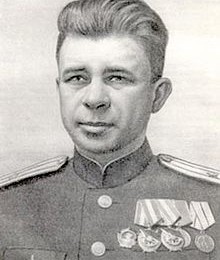
Alexander Marinesko. Hero.
It w as New Year’s night 1945 in Hanko when Alexander Marinesko, 32, commander of S-13, the Red Fleets most advanced submarine, romanced a Swedish restaurant owner and spent the next few days AWOL drinking with her. This was a double offence, desertion, a capital offence, as well as fraternisation between a Soviet citizen and a foreigner, which was prohibited. The commander of the Baltic Fleet Admiral V. F. Tributs realized that disciplining Marinesko would delay operations for their leading submarine and so instead he was sent out from Hanko with S-13 on January 11, 1945 and took position near Kolberg on January 13.
as New Year’s night 1945 in Hanko when Alexander Marinesko, 32, commander of S-13, the Red Fleets most advanced submarine, romanced a Swedish restaurant owner and spent the next few days AWOL drinking with her. This was a double offence, desertion, a capital offence, as well as fraternisation between a Soviet citizen and a foreigner, which was prohibited. The commander of the Baltic Fleet Admiral V. F. Tributs realized that disciplining Marinesko would delay operations for their leading submarine and so instead he was sent out from Hanko with S-13 on January 11, 1945 and took position near Kolberg on January 13.
Meanwhile early on 30 January, 1945 the MV Wilhelm Gustloff Germanys largest cruise ship constructed for the Nazi Kraft durch Freude Strength Through Joy organisation in 1937 was setting off from Gotenhafen to Kiel, accompanied by the passenger liner Hansa and two torpedo boats. The MV Wilhelm Gustloff was loaded with up to 10,000 passengers, most of whom were refugees escaping the advancing Red Army as a part of Operation Hannibal, the naval evacuation of German troops and civilians from Courland, East Prussia and the Polish Corridor.
The water temperature in the Baltic Sea at this time of year is usually around 4 °C (39 °F); however, this was a particularly cold night, with an air temperature of −18 to −10 °C (0 to 14 °F) and ice floes covering the surface
Marinesko, submerged and enjoying his customary vodka followed the ships for two hours before launching three torpedoes at the Wilhelm Gustloff′s port side about 30 km offshore between Großendorf and Leba soon after 21:00 hitting it with all three. The first torpedo (with a text written on it: “For the Motherland“) struck near the port bow. The second torpedo (“For the Soviet people“) hit just ahead of midships. The third torpedo (“For Leningrad“) struck the engine room in the area below the ship’s funnel, cutting off electrical power to the ship. The Gustloff took a light list to port and settled rapidly by the head.
The first torpedo caused the watertight doors to seal off the bow which contained the crews’ quarters where off-duty crew members were sleeping. The second torpedo hit the accommodations for the Women’s Naval Auxiliary; only three of the 373 quartered there survived. The third torpedo was a direct hit on the engine room, cutting all power and communications. Reportedly, only one lifeboat was able to be lowered, the rest had frozen in their davits and had to be broken free with some lost when they fell or capsized as a result of the panic
Many deaths were caused either directly by the torpedoes or by drowning in the onrushing water. Others were crushed in the initial panic on the stairs and decks, and many jumped into the icy Baltic. The majority of those who perished succumbed to exposure in the freezing water.
Less than 40 minutes after being struck, the Wilhelm Gustloff was lying on her side and sank bow-first, in 44 m (144 ft) of water. Thousands of people were trapped inside on the promenade deck.
The figures from the research of Heinz Schön, one of the shipwreck’s survivors and a prolific German author and historian on the subject of the Wilhelm Gustloff make the total lost in the sinking to be about 9,343 total, including about 5,000 children.
Days later, on February 10, Marinesko sank a second German ship with two torpedoes, the Steuben, this time carrying mostly military personnel, with an estimated total number of 4,267 casualties.Marinesko had maneuvered submerged for four hours, drinking vodka constantly while following the enemy by sonar. Marinesko thus became the most successful Soviet submarine commander in terms of gross register tonnage (GRT) sunk, with 42,000 GRT to his name. Following the sinking of the Steuben, Hitler had Alexander Marinesko declared a “personal enemy.
Before sinking the Gustloff, Alexander Marinesko was facing a court martial due to his problems with alcohol and womanizing and was thus deemed “not suitable to be a hero” for his actions and was instead awarded the Order of the Red Banner. Although widely recognized as a brilliant commander, he was downgraded in rank to lieutenant and dishonorably discharged from the Navy in October 1945. In 1960 he was reinstated as Captain Third Class and granted a full pension. In 1963 Marinesko was given the traditional ceremony due to a captain upon his successful return from a mission. He died three weeks later from cancer. Aged 50. Marinesko was posthumously awarded Hero of the Soviet Union by Mikhail Gorbachev in 1990.
But is he a hero?
